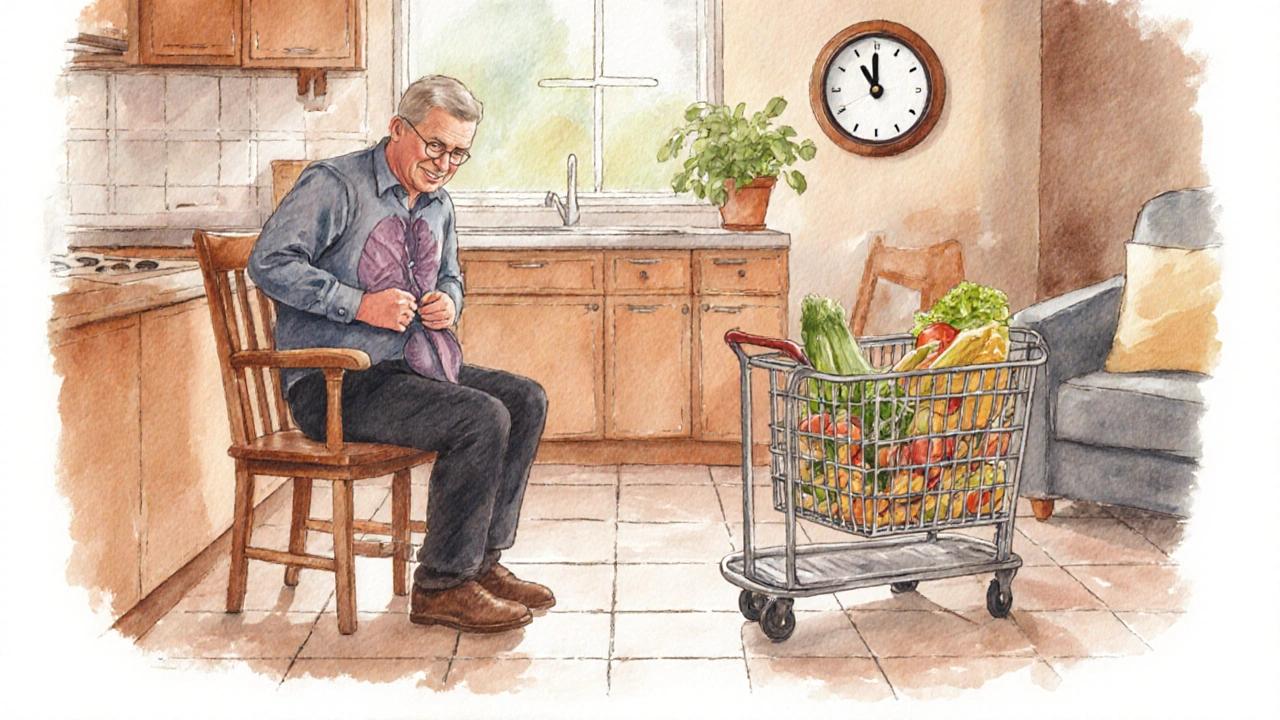Emphysema Fatigue Management Planner
Sit While Dressing
Reduces standing-related breathlessness
Batch Similar Tasks
Minimises repeated trips and lung-stress
Use Rolling Cart
Less weight carried, steadier breathing
Rest Breaks Every 20-30 Minutes
Prevents cumulative fatigue
Pursed-Lip Breathing
Inhale slowly through nose, exhale gently through pursed lips as if blowing out a candle.
Diaphragmatic Breathing
Place hands on chest and abdomen. Breathe so belly rises more than chest.
Your Personalized Daily Plan
Quick Take
- Identify the main triggers of Emphysema fatigue - poor oxygen, activity spikes, bad sleep.
- Use breathing techniques like pursed‑lip breathing to lower breathlessness.
- Plan your day with energy‑conservation tactics (sit while dressing, break tasks).
- Boost nutrition with high‑protein, antioxidant‑rich foods to support lung repair.
- Know the red flags that require a doctor’s visit, such as sudden worsening of fatigue.
Understanding Emphysema‑Related Fatigue
When dealing with Emphysema‑related fatigue is a persistent feeling of exhaustion that many people with emphysema experience, often worsening throughout the day, it helps to see the condition in context. Emphysema is a form of Chronic Obstructive Pulmonary Disease (COPD) that destroys alveolar walls, reducing the surface area for gas exchange. Less oxygen reaching muscles means they tire faster, and the constant effort to breathe itself burns energy.
Typical triggers include low blood‑oxygen levels, infections, poor sleep, and even emotional stress. Recognising these patterns lets you intervene before fatigue spirals out of control.
Medical Foundations: What Helps Physically?
Two core medical tools often make a big difference:
- Oxygen Therapy is a treatment that supplies supplemental oxygen to keep blood‑oxygen saturation above 90%. When oxygen levels stay stable, the heart doesn’t have to work overtime, and fatigue drops.
- Pulmonary Rehabilitation is a structured program of exercise, education, and support designed for people with chronic lung disease. Regular, supervised activity boosts muscle efficiency and teaches energy‑saving techniques.
Talk to your pulmonologist about whether these options suit your stage of disease.
Breathing Techniques that Cut Exhaustion
Breathing feels automatic, but tweaking how you inhale and exhale can free up energy.
- Pursed‑Lip Breathing: Inhale slowly through the nose, then exhale gently through pursed lips as if blowing out a candle. This creates back‑pressure that keeps airways open longer, reducing breathlessness.
- Diaphragmatic Breathing: Place one hand on your chest and the other on your abdomen. Breathe so the belly rises more than the chest. Engaging the diaphragm is more efficient than shallow chest breathing.
Practice these for 5‑10 minutes each morning; you’ll notice a steadier rhythm and less rapid fatigue during daily chores.

Energy‑Conservation Strategies for Everyday Life
Think of your day as a battery you need to stretch. The following tactics are proven to keep the charge lasting longer.
| Strategy | Typical Benefit | Best Time to Use |
|---|---|---|
| Sit while dressing or shaving | Reduces standing‑related breathlessness | Morning routine |
| Batch similar tasks (e.g., meal prep, laundry) | Minimises repeated trips and lung‑stress | Afternoon when energy dips |
| Use a rolling cart for groceries | Less weight carried, steadier breathing | Shopping trips |
| Plan rest breaks every 20‑30 minutes | Prevents cumulative fatigue | Extended activities like gardening |
| Prioritise high‑impact chores first | Ensures critical tasks get done when you’re freshest | Morning hours |
Adopt at least three of these each week and track how your energy levels respond.
Nutrition That Fuels Lungs and Muscles
What you eat directly influences how hard your body works to breathe.
- High‑Protein Foods such as lean meat, beans, and Greek yogurt help maintain muscle mass, which in turn improves respiratory muscles.
- Antioxidant‑Rich Produce (berries, leafy greens, citrus) combats oxidative stress that can worsen lung tissue damage.
- Omega‑3 Fatty Acids found in fish and flaxseed have anti‑inflammatory properties beneficial for airway health.
Stay hydrated - water thins mucus, making it easier to clear and reducing the work of coughing, which can drain energy.
Sleep Hygiene for Better Recovery
Poor sleep is a hidden driver of daytime fatigue. Follow these simple steps:
- Keep the bedroom cool (around 18‑20°C) and free of allergens.
- Use a humidifier if the air is dry; dry air irritates airways.
- Elevate the head of the bed slightly to reduce nighttime breathlessness.
- Establish a consistent bedtime routine - reading, gentle stretching, or a short breathing exercise.
If you wake up feeling short of breath, consider a brief use of your prescribed oxygen during sleep; many patients report smoother mornings.
When to Seek Professional Help
Fatigue isn’t always manageable at home. Contact your healthcare team if you notice any of the following:
- Sudden, sharp decline in energy that lasts more than a week.
- New or worsening shortness of breath at rest.
- Unintended weight loss or loss of appetite.
- Signs of depression or anxiety that interfere with daily life.
These could signal an infection, worsening emphysema, or a need to adjust medication or oxygen settings.
Putting It All Together: A Sample Day Plan
Below is a realistic schedule that blends the tips above. Adjust times to fit your routine.
- 07:00 - Wake Up: Do diaphragmatic breathing for 5 minutes, then sip a glass of water.
- 07:30 - Breakfast: High‑protein oatmeal topped with berries and a sprinkle of flaxseed.
- 08:00 - Light Exercise: 10‑minute walk using pursed‑lip breathing, followed by gentle stretches.
- 09:00 - Morning Tasks: Sit while dressing, then batch email replies and bill payments.
- 11:00 - Rest Break: Sit, practice pursed‑lip breathing, hydrate.
- 12:30 - Lunch: Grilled chicken salad with leafy greens, olive oil, and citrus dressing.
- 13:00 - Mid‑Afternoon: Use a rolling cart for a quick grocery run; rest for 10 minutes afterward.
- 15:00 - Energy‑Saving Window: Light house chores (dusting, vacuuming) with breaks every 20 minutes.
- 18:00 - Dinner: Baked salmon, sweet potato, and steamed broccoli.
- 19:30 - Wind Down: Warm shower, elevate head of bed, short breathing session.
- 22:00 - Bedtime: Follow sleep hygiene routine, consider overnight oxygen if prescribed.
This blueprint shows how a few small adjustments can keep fatigue at bay while still getting important tasks done.

Frequently Asked Questions
Why does my fatigue get worse in the afternoon?
By late afternoon, your body’s oxygen reserves are lower, and daily activities have accumulated. Hormonal changes also lower alertness, making breathlessness feel more tiring. Using an energy‑conservation plan and a short afternoon rest can smooth out the dip.
Can I rely only on medication to fix the fatigue?
Medication helps manage inflammation and airflow, but fatigue is multi‑factorial. Lifestyle tweaks-breathing exercises, nutrition, sleep, and pacing-are essential complements to any drug regimen.
Is it safe to exercise if I’m always tired?
Yes, but keep it low‑intensity and supervised. Activities like walking, stationary cycling, or gentle yoga improve muscle efficiency and can actually reduce fatigue over time.
Should I adjust my oxygen flow at night?
Only under a doctor’s guidance. Some patients need a higher flow while sleeping to maintain stable oxygen saturation, which can lessen morning fatigue.
What foods should I avoid to keep energy up?
Limit processed sugars, excessive salty snacks, and heavy fried meals. These can cause inflammation, blood‑sugar swings, and make breathing feel harder.


13 Comments
Jennifer Ferrara
1 October, 2025Having perused the presented strategies, one discerns a commendable integration of pulmonary rehabilitation principles. The emphasis on diaphragmatic breathing aligns with extant clinical guidelines. Moreover, the suggestion to batch tasks may attenuate cumulative exertion, albeit the implementation details could be expended. It is also prudent to monitor oxygen saturation during prolonged activities, as hypoxemia can precipitate rapid fatigue. In sum, the plan offers a solid scaffolding, though further personalization might augmnet the efficacy.
Terry Moreland
3 October, 2025Hey, this is really solid stuff. I’ve been using the breathing drills every morning and notice I’m less winded by lunch. Splitting chores into little blocks and taking a quick sit‑down break works wonders for my energy. Keep tweaking the schedule until it feels right – you’ve got this!
Abdul Adeeb
6 October, 2025While the anecdotal observations are valuable, certain linguistic inaccuracies merit correction. The phrase “I’ve been using the breathing drills” should be followed by a comma before “and”. Additionally, “splitting chores into little blocks” would be more precise as “splitting chores into smaller blocks”. Clinically, incorporating pulse‑oximetry readings can objectively gauge the impact of pacing strategies. Nevertheless, the practical advice remains sound.
Abhishek Vernekar
9 October, 2025The data you just laid out feels a bit cold, doesn’t it? It’s okay to sprinkle some empathy between the commas – after all, fatigue is more than numbers. I’ve felt the sting of breathlessness after a simple walk, and a little kind word to yourself can lift the mood. Remember, you’re not just a collection of protocols; you’re a person who deserves compassion.
Val Vaden
13 October, 2025Looks like another generic checklist 🙄.
lalitha vadlamani
16 October, 2025Such a cursory dismissal of the nuanced regimen betrays a lamentable superficiality, for the battle against emphysemic fatigue demands reverent scrutiny and unwavering devotion.
kirk lapan
20 October, 2025Yo, if you think the plan is just a copy‑paste from some health blog, you’re missing the deep science. Oxygen therapy isn’t a plug‑and‑play gadget; it’s calibrated to your PaO2 levels, not just a vibe. Also, the “rest every 20‑30 minutes” rule is actually rooted in the 2018 GOLD guidelines – you can’t just ignore that. So yeah, get a real pulmonary physio to fine‑tune the schedule, otherwise you’re wasting time.
Kevin Huckaby
23 October, 2025Honestly, buddy, you sound like a textbook robot 🤖-why not spice it up with some real‑life hacks? 🌶️🔥
Brandon McInnis
27 October, 2025I appreciate the varied perspectives swirling here; it’s like a symphony of coping tactics. When you blend proper breathing, nutrition, and paced activity, you can really conduct your day without the discord of exhaustion. Let’s all remember to respect each other’s journeys and keep the conversation uplifting.
Aaron Miller
30 October, 2025Wow!!! This is exactly the kind of feel‑good fluff that ignores the harsh reality!!! Not everyone can just ‘blend’ strategies without confronting the brutal fact that many lack access to oxygen therapy!!!
Roshin Ramakrishnan
3 November, 2025Indeed, the challenges you highlight are very real!!! However, sharing practical tips-like using a rolling cart or setting consistent rest intervals-can empower those facing limitations!!! Let’s keep the dialogue constructive and inclusive!!!
Todd Peeples
7 November, 2025The integrative fatigue mitigation framework delineated herein warrants a comprehensive appraisal from both a physiologic and a behavioral standpoint.
Foremost, the implementation of pursed‑lip breathing synergistically augments expiratory flow limitation, thereby attenuating dynamic hyperinflation.
Concomitantly, diaphragmatic respiration optimizes tidal volume distribution, fostering alveolar ventilation efficiency.
From a metabolic perspective, high‑protein ingestion post‑exercise facilitates anabolism of respiratory musculature, a critical determinant of sustained ventilatory capacity.
Antioxidant‑rich phytonutrients, such as flavonoids, mitigate oxidative stress pathways that exacerbate inflammatory cascades within compromised parenchyma.
The recommendation to regiment rest intervals at 20‑ to 30‑minute cadence aligns with the concept of micro‑recovery, which has been substantiated in recent longitudinal COPD cohort analyses.
Moreover, the strategic deployment of a rolling cart reduces biomechanical load, thereby conserving inspiratory effort during ambulation.
Batch processing of homogenous tasks curtails repetitive postural transitions, which are known to precipitate transient desaturation events.
Chronobiological profiling of energy peaks suggests a diurnal variance, with maximal performance typically observed in the late morning to early afternoon window.
Thus, scheduling high‑intensity activities within this temporal niche can capitalize on endogenous hormonal surges, such as cortisol and catecholamines.
Sleep hygiene protocols, including ambient temperature regulation and nocturnal humidification, serve to ameliorate nocturnal hypoventilation, a frequent catalyst for morning fatigue.
The elevation of the head of the bed by approximately 15 centimeters has been demonstrated to reduce functional residual capacity collapse during recumbency.
Patients should routinely calibrate their supplemental oxygen flow rates against pulse‑oximetry trends to preempt hypoxic episodes during activity bursts.
Incorporating psychosocial support mechanisms, such as peer‑led education groups, can bolster self‑efficacy and mitigate the depressive sequelae associated with chronic breathlessness.
All aforementioned interventions coalesce into a multimodal paradigm that transcends monolithic therapeutic approaches.
Ultimately, personalized adherence to this evidence‑based schema is poised to attenuate the burdensome fatigue that pervades the lives of individuals contending with emphysematous pathology 😊.
Chris Smith
10 November, 2025Great, another PowerPoint slide 🙄